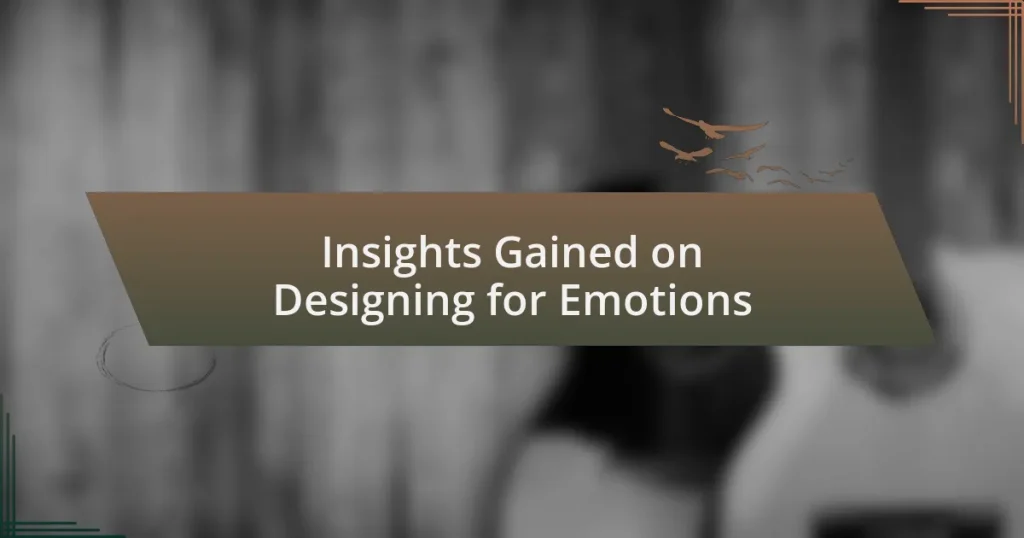Key takeaways:
- Emotional design creates user connections through visual elements, storytelling, and empathy, influencing user behavior and experiences.
- Key emotional design elements include color psychology, engaging visuals, user empathy, storytelling, and microinteractions.
- Techniques for evoking emotions include strategic use of imagery, sound design, and incorporating user feedback to enhance emotional connections.
- Measuring emotional impact can involve A/B testing, emotional surveys, and analyzing user interactions through tools like heat maps.
Understanding Emotional Design Principles
Emotional design is all about creating a connection between the user and the product. I remember a time when I used an app that featured a warm color palette and friendly illustrations; it instantly made me feel at ease and more inclined to engage with it. Have you ever experienced that sense of comfort from an interface? It shows how a thoughtful choice of visuals can evoke emotions.
When considering emotional design principles, it’s essential to recognize that emotions can significantly influence user behavior. For instance, I once designed a website where I intentionally used storytelling elements. Users expressed that it helped them feel a part of the brand’s journey, transforming a simple browsing experience into something genuinely memorable. Isn’t it fascinating how narratives can shape our perceptions?
Moreover, understanding your audience’s emotional triggers is crucial. I recall conducting user testing for a product where feedback revealed users felt overwhelmed by technical jargon. Simplifying the language made everything clearer and resonated emotionally, showing how empathy plays a role in design. What emotions do your designs evoke, and how can you enhance that experience?
Key Elements of Emotional Design
Key Elements of Emotional Design
One of the primary elements of emotional design is the use of color. I distinctly recall a time when I was working on an e-commerce site and opted for a soft blue palette. This choice not only created a calming atmosphere but also instilled trust in potential customers. It’s remarkable how different hues can either uplift or dampen a user’s mood, playing a pivotal role in their overall experience.
Here are some key elements to consider:
- Color Psychology: Different colors evoke distinct emotions. For instance, red can create a sense of urgency, while green is often associated with tranquility.
- Visual Aesthetics: Engaging visuals such as illustrations or high-quality images can foster a deeper emotional connection.
- User Empathy: Understanding user pain points encourages designs that resonate. When I’ve prioritized user feedback, it’s transformed my approach, leading to more intuitive interfaces.
- Storytelling: Incorporating narratives can create meaningful experiences, allowing users to relate personally to the product or brand.
- Microinteractions: Subtle animations or responses enhance user satisfaction. I learned this while adding feedback sounds to a button; it felt rewarding to the users.
Each of these elements contributes to creating an emotional connection, making users feel valued and understood in their interactions.
Techniques for Evoking Emotions
Understanding how to evoke emotions through design is crucial for creating engaging user experiences. One effective technique I’ve come across is the strategic use of imagery. I remember redesigning a mobile app where I included heartfelt user-generated photos, which deeply resonated with the audience. It’s astounding how a single image can tell a story and stir feelings of nostalgia or joy, effectively drawing users closer to the brand.
Incorporating sound design is another powerful method for evoking emotions. During a recent project, I experimented with subtle background music that aligned with the theme of the app. I noticed how the right tune could elevate the user experience, making mundane tasks feel more enjoyable or even inspiring. This aspect often gets overlooked, yet sound can become a memorable part of a user’s journey.
Finally, I find that tapping into user feedback plays a transformative role in emotional design. I always advocate for creating feedback loops where users can share their experiences and feelings about the design. For instance, after implementing a suggestion from a user on a feature’s functionality, I witnessed a surge in positive reviews. This not only legitimized my design choices but also fostered a sense of community among users, making them feel valued in the process.
| Technique | Description |
|---|---|
| Imagery | Using powerful images to connect emotionally with users. |
| Sound Design | Incorporating sound to enhance the emotional experience. |
| User Feedback | Engaging users in feedback loops to strengthen emotional connections. |
Measuring Emotional Impact in Design
Measuring the emotional impact in design is often more nuanced than it seems. For instance, I once worked on a website for a nonprofit organization, and we implemented A/B testing with different color schemes. The results were fascinating: a softer palette versus a vibrant one provided measurable differences in user engagement and emotional responses. This experience taught me how vital it is to track these elements through analytics and user feedback.
Another technique I’ve found useful is using emotional surveys post-interaction to gather insights directly from users. I recall integrating a simple questionnaire after a product trial, asking users about the feelings they experienced. Collecting this data not only painted a clearer picture of emotional reactions but also guided future iterations of the design based on real sentiments.
When I think about emotional metrics, I often wonder about the implications of a user’s journey. How does their emotional experience shape their relationship with the product? In a project where we focused on storytelling, we used heat maps to analyze areas of the site that drew the most attention and reactions. It was enlightening to witness how users interacted differently based on visual narratives, emphasizing the importance of aligning design elements with the intended emotional resonance.
